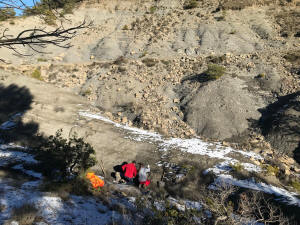Fossils of car-sized dinosaur-era sea turtle unearthed in Spain
 Send a link to a friend
Send a link to a friend
 [November 18, 2022]
By Will Dunham [November 18, 2022]
By Will Dunham
(Reuters) - Plying the subtropical seas
that washed the coasts of the archipelago that made up Europe 83 million
years ago was one of the largest turtles on record, a reptile the size
of a small car - a Mini Cooper to be precise - that braved dangerous
waters.
Researchers on Thursday described remains discovered in northeastern
Spain of a turtle named Leviathanochelys aenigmatica that was about 12
feet (3.7 meters) long, weighed a bit under two tons and lived during
the Cretaceous Period - the final chapter in the age of dinosaurs. It is
Europe's biggest-known turtle.
It dwarfed today's largest turtle - the leatherback, which can reach 7
feet (2 meters) long and is known for marathon marine migrations.
Leviathanochelys nearly matched the largest turtle on record - Archelon,
which lived roughly 70 million years ago and reached about 15 feet (4.6
meters) long.
"Leviathanochelys was as long as a Mini Cooper while Archelon was the
same size as a Toyota Corolla," said paleontologist and study co-author
Albert SellÚs of the Institut CatalÓ de Paleontologia (ICP), a research
center affiliated with Universitat Aut˛noma de Barcelona.
It was good to be the size of a car, considering the hazardous traffic
in the ancient Tethys Sea in which Leviathanochelys swam. Huge marine
reptiles with powerful jaws called mosasaurs were the largest predators
- some exceeding 50 feet (15 meters) in length. Various sharks and rays
as well as long-necked fish-eating marine reptiles called plesiosaurs
also lurked.

"Attacking an animal of the size of Leviathanochelys possibly only could
have been done by large predators in the marine context. At that time,
the large marine predators in the European zone were mainly sharks and
mosasaurs," said Oscar Castillo, a student in a master's degree program
in paleontology at Universitat Aut˛noma de Barcelona and lead author of
the study published in the journal Scientific Reports.
"During the Cretaceous, there was a tendency in marine turtles to
increase their body size. Leviathanochelys and Archelon might represent
the apex of this process. The reason for this increase in body size has
been hypothesized to be predatory pressures, but there might be other
factors," Castillo added.
[to top of second column]
|

The excavation site where fossils of the
large Cretaceous Period sea turtle Leviathanochelys aenigmatica,
which lived about 83 million years ago, were found in Catalonia's
Alt Urgell county in northeastern Spain is seen in this undated
handout image. Angel Galobart/Museu de la Conca Della - Institut
Catala de Paleontologia Miquel Crusafont/Handout via REUTERS

Other large turtles from Earth's past include Protostega and
Stupendemys, both reaching about 13 feet (4 meters) long. Protostega
was a Cretaceous sea turtle that lived about 85 million years ago
and, like its later cousin Archelon, inhabited the large inland sea
that at the time split North America in two. Stupendemys prowled the
lakes and rivers of northern South America about 7-13 million years
ago during the Miocene Epoch.
Scientists unearthed the Leviathanochelys remains near the village
of Coll de Nargˇ in Catalonia's Alt Urgell county after fossils
protruding from the ground were spotted by a hiker in the Southern
Pyrenees mountains. To date, they have found parts of the posterior
portion of its carapace, or shell, and most of the pelvic girdle,
but no skull, tail or limbs.
The fossils indicated that it possessed a smooth carapace similar to
leatherback turtles, with the shell itself about 7.7 feet (2.35
meters) long and 7.2 feet (2.2 meters) wide. Leviathanochelys
appears built for the open ocean, returning to land only rarely -
for instance to lay eggs.
The presence of a couple of bony bulges on the front side of the
pelvis differs from any other known sea turtle, indicating that
Leviathanochelys represents a newly discovered lineage. It shows
that gigantism in marine turtles developed independently in separate
Cretaceous lineages in North America and Europe.
Leviathanochelys aenigmatica means "enigmatic leviathan turtle"
owing to its large size and the curious shape of its pelvis that the
researchers suspect was related to its respiratory system.
"Some pelagic (living in the open ocean) animals show a modification
in their respiratory system to maximize their breathing capacity at
great depths," SellÚs said.
(Reporting by Will Dunham in Washington, Editing by Rosalba O'Brien)
[ę 2022 Thomson Reuters. All rights
reserved.]
This material may not be published,
broadcast, rewritten or redistributed.
Thompson Reuters is solely responsible for this content.
 |